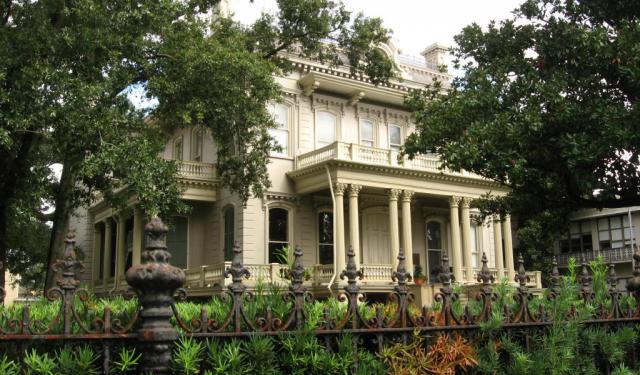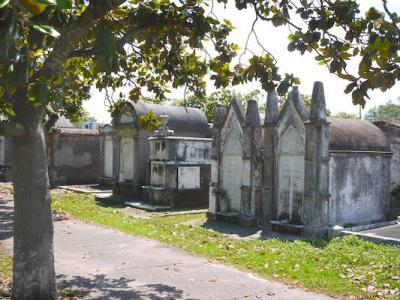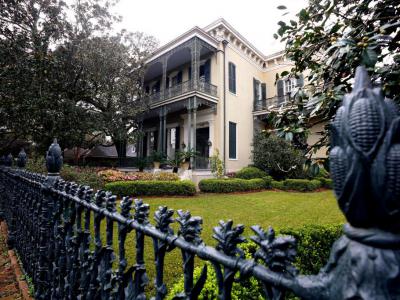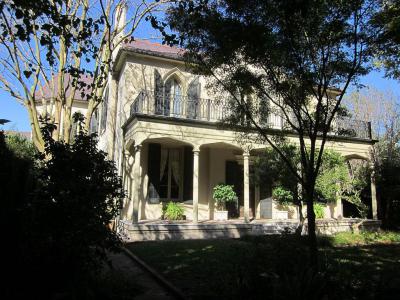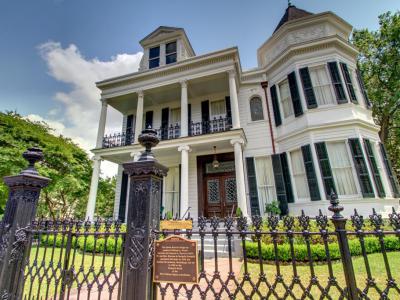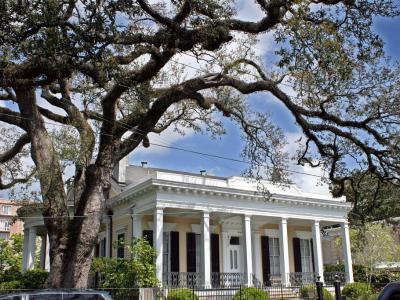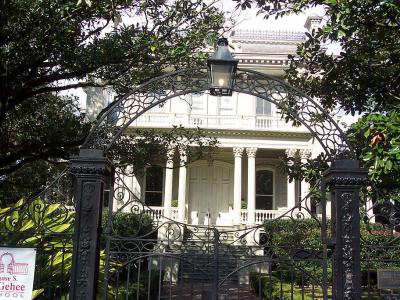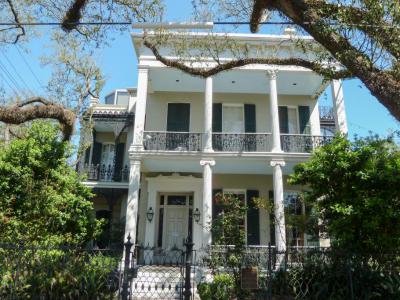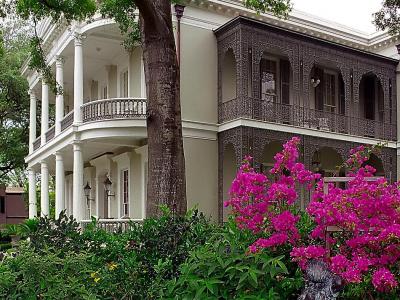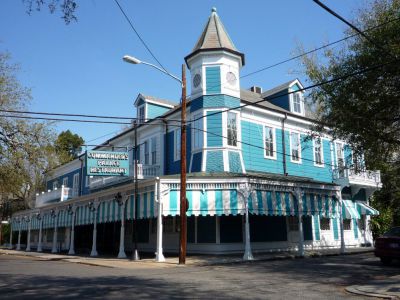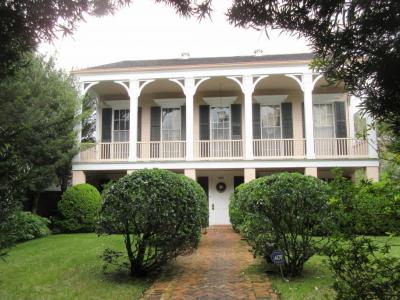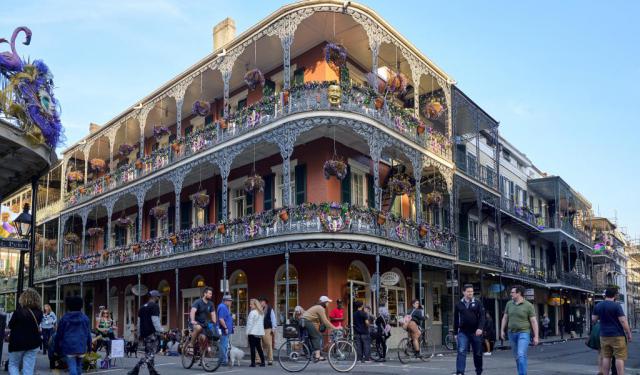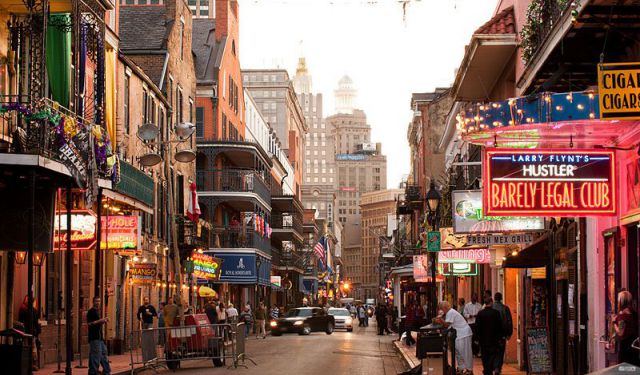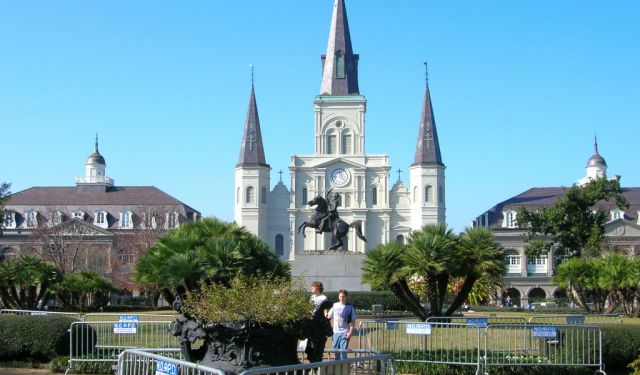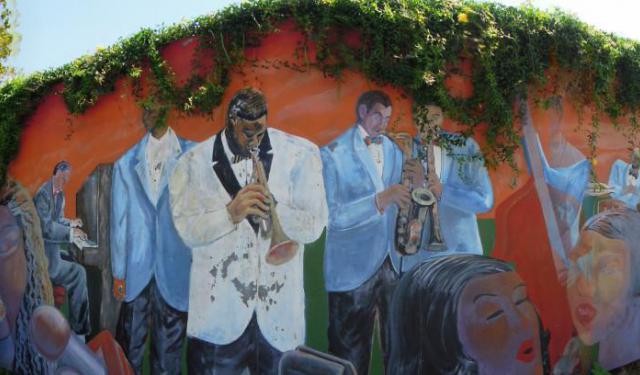Garden District Walking Tour (Self Guided), New Orleans
It may come as a surprise, but New Orleans’ Garden District is known for its architecture more than for its gardens. The city’s elite residential neighborhood since the 19th century, when wealthy newcomers built opulent structures, it is considered one of the best-preserved collections of historic mansions in the South, and certainly one of the most picturesque. You can see why this is the setting for so many novels.
Take a walking tour of the district to see most of its majestic homes, including that of bestselling author Anne Rice or that of sugar baron Bradish Johnson. The Women’s Opera Guild House is your only chance to get an interior look, and still contains many period furnishings. Reservations aren’t necessary and the women who provide the tours always give great insight into the home and past/current New Orleans society.
Along with these and numerous other heritage sites, you’ll get to discover the famous time-worn tombs of Lafayette Cemetery No. 1, as well as the Commander's Palace – one of the best restaurants in town since it opened back in 1880. After you've checked all of these off the list, you may as well walk down to nearby Magazine Street for a great mix of shopping and eateries.
For a great day out in the fabulous Garden District, pick a day with nice weather and follow this self-guided walking tour.
Take a walking tour of the district to see most of its majestic homes, including that of bestselling author Anne Rice or that of sugar baron Bradish Johnson. The Women’s Opera Guild House is your only chance to get an interior look, and still contains many period furnishings. Reservations aren’t necessary and the women who provide the tours always give great insight into the home and past/current New Orleans society.
Along with these and numerous other heritage sites, you’ll get to discover the famous time-worn tombs of Lafayette Cemetery No. 1, as well as the Commander's Palace – one of the best restaurants in town since it opened back in 1880. After you've checked all of these off the list, you may as well walk down to nearby Magazine Street for a great mix of shopping and eateries.
For a great day out in the fabulous Garden District, pick a day with nice weather and follow this self-guided walking tour.
How it works: Download the app "GPSmyCity: Walks in 1K+ Cities" from Apple App Store or Google Play Store to your mobile phone or tablet. The app turns your mobile device into a personal tour guide and its built-in GPS navigation functions guide you from one tour stop to next. The app works offline, so no data plan is needed when traveling abroad.
Garden District Walking Tour Map
Guide Name: Garden District Walking Tour
Guide Location: USA » New Orleans (See other walking tours in New Orleans)
Guide Type: Self-guided Walking Tour (Sightseeing)
# of Attractions: 10
Tour Duration: 1 Hour(s)
Travel Distance: 1.9 Km or 1.2 Miles
Author: DanaOffice
Sight(s) Featured in This Guide:
Guide Location: USA » New Orleans (See other walking tours in New Orleans)
Guide Type: Self-guided Walking Tour (Sightseeing)
# of Attractions: 10
Tour Duration: 1 Hour(s)
Travel Distance: 1.9 Km or 1.2 Miles
Author: DanaOffice
Sight(s) Featured in This Guide:
- Lafayette Cemetery No. 1
- Colonel Short's Villa
- Briggs-Staub House
- Opera Guild Home
- Adams-Jones House
- Louise S. McGehee School
- Anne Rice House (aka Rosegate House)
- Walter Grinnan Robinson House
- Commander's Palace
- George Washington Cable House
1) Lafayette Cemetery No. 1 (must see)
New Orleans' cemeteries are undeniably unique and should be on your must-see list before bidding adieu to the city. Located conveniently in the Garden District, a charming neighborhood perfect for leisurely strolls, Lafayette No. 1 Cemetery offers a hauntingly beautiful spectacle that encapsulates the essence of NOLA. It's freely accessible to the public and aligns perfectly with the imagery associated with New Orleans, even serving as the backdrop for scenes in Anne Rice's "Interview with the Vampire."
Established in 1833, this cemetery witnessed a wave of immigrants, including Italians, Germans, Irish, and Northern Americans, who flocked to New Orleans. Many individuals with ties to the Civil War rest here, marked by plaques and headstones detailing the location of their demise. Additionally, the cemetery bears witness to the devastating yellow fever epidemic of 1852, which predominantly affected newcomers and children, resulting in the burial of around 2,000 yellow fever victims.
Don't forget your camera as you meander through the rows of raised crypts. You can choose to explore independently during open hours or opt for a guided tour in the morning. In either case, Lafayette No. 1 Cemetery is a remarkable historical site that's well worth your visit!
Tip:
Exercise caution while walking, as the pathways may be in poor condition. Being mindful of your step is crucial to avoid ankle sprains.
Established in 1833, this cemetery witnessed a wave of immigrants, including Italians, Germans, Irish, and Northern Americans, who flocked to New Orleans. Many individuals with ties to the Civil War rest here, marked by plaques and headstones detailing the location of their demise. Additionally, the cemetery bears witness to the devastating yellow fever epidemic of 1852, which predominantly affected newcomers and children, resulting in the burial of around 2,000 yellow fever victims.
Don't forget your camera as you meander through the rows of raised crypts. You can choose to explore independently during open hours or opt for a guided tour in the morning. In either case, Lafayette No. 1 Cemetery is a remarkable historical site that's well worth your visit!
Tip:
Exercise caution while walking, as the pathways may be in poor condition. Being mindful of your step is crucial to avoid ankle sprains.
2) Colonel Short's Villa
Built in 1859 for Colonel Robert Short of Kentucky and masterfully designed by Henry Howard, this Italian-Renaissance villa is most renowned for its remarkable ironwork fence, adorned with intricate morning glory and cornstalk motifs. Legend has it that Short's wife expressed her longing for the cornfields of her native Iowa, prompting him to purchase the iconic cornstalk fence, one of only three of its kind in the entire United States. Unlike a similar one on Royal Street, this one has retained its original colors and hasn't been painted over.
During the Civil War, the house was confiscated by federal forces in 1863 and briefly served as the executive mansion for the federal governor of Louisiana before being returned to Short, who continued to reside there for the remainder of his life. After undergoing a painstaking, decade-long restoration, the property was listed for $5 million in 2015, marking it as the most expensive listing in New Orleans at the time. While the villa is a private residence, you can still marvel at the unique fence up close from the sidewalk.
During the Civil War, the house was confiscated by federal forces in 1863 and briefly served as the executive mansion for the federal governor of Louisiana before being returned to Short, who continued to reside there for the remainder of his life. After undergoing a painstaking, decade-long restoration, the property was listed for $5 million in 2015, marking it as the most expensive listing in New Orleans at the time. While the villa is a private residence, you can still marvel at the unique fence up close from the sidewalk.
3) Briggs-Staub House
The Briggs-Staub House on Prytania Street defied the conventional architectural style of the Garden District when it was constructed for planter Cuthbert Bullitt in 1849. It notably features Gothic arched windows, a departure from the typical Garden District Protestant American homes of the time. Many in this community avoided Gothic Revival architecture because it reminded them of the Roman Catholicism associated with their Creole rivals.
Upon its completion by architect James Gallier, Jr., Bullitt refused to settle the bill, purportedly due to significant gambling losses. Consequently, the house changed hands and was acquired by Charles Briggs, an English insurance executive. Briggs resided here during a period of Irish immigration to the area and, rather than hold African slaves, opted to hire Irish servants, for whom he built a relatively spacious matching servant quarters. While the interior of the house departs from a strict Gothic room layout, making it better suited for hosting gatherings, Gothic architectural elements are prominently featured both inside and outside the structure.
Upon its completion by architect James Gallier, Jr., Bullitt refused to settle the bill, purportedly due to significant gambling losses. Consequently, the house changed hands and was acquired by Charles Briggs, an English insurance executive. Briggs resided here during a period of Irish immigration to the area and, rather than hold African slaves, opted to hire Irish servants, for whom he built a relatively spacious matching servant quarters. While the interior of the house departs from a strict Gothic room layout, making it better suited for hosting gatherings, Gothic architectural elements are prominently featured both inside and outside the structure.
4) Opera Guild Home
Some of the most notable residences in the Garden District blend multiple architectural styles. Designed by architect William A. Freret in 1858, this particular house combines elements of Greek Revival design with additions in the Queen Anne style (the octagonal turret was added in the late 19th century). Its original owner, a wealthy merchant, apparently suffered financial ruin after the Civil War and could not meet his financial obligations. In 1867, Freret repurchased the house at auction for a mere $30,700. Later, in 1944, it was acquired for just $12,500 by Dr. Herman Seebold and his wife Nettie, an affluent couple with a passion for art, music, and worldly travels. They spared no expense in adorning the house with opulent furnishings.
By 1965, the Seebolds had passed away with no heir apparent. In Mrs. Seebold's handwritten will, she bequeathed the magnificent residence and all its contents to the Opera Women's Guild; a stipulation noted that the 18th- and 19th-century treasures inside were not to be sold or removed. Today, the house is available for rent for various events, including weddings, dinners, film shoots, and luncheons, with proceeds going to support the New Orleans Opera Association.
Tip:
Visit the website to reserve a tour!
By 1965, the Seebolds had passed away with no heir apparent. In Mrs. Seebold's handwritten will, she bequeathed the magnificent residence and all its contents to the Opera Women's Guild; a stipulation noted that the 18th- and 19th-century treasures inside were not to be sold or removed. Today, the house is available for rent for various events, including weddings, dinners, film shoots, and luncheons, with proceeds going to support the New Orleans Opera Association.
Tip:
Visit the website to reserve a tour!
5) Adams-Jones House
Sitting proudly beneath the watchful eyes of some seriously grand live oaks, this house was originally built for John I. Adams, a merchant who must have been feeling pretty fancy when he decided to set up shop in what would later become the Garden District. Adams, with a penchant for prime real estate, purchased this fine piece of property back in 1860. He rolled up his sleeves, put on his best builder's hat, and took up residence in the house, happily living there until 1896.
After Adams, the house had a rollercoaster of owners, probably discussing property values and wallpaper choices over the years. Fast forward to the swinging '60s when Mrs. Hamilton Polk Jones decided it was time for a little house makeover. She lovingly restored it, ensuring it wouldn't be embarrassed to show its face at historical landmark parties. And just to make things official, the New Orleans Landmarks Commission bestowed the title of historical landmark upon it in 1995. So, next time you stroll by, tip your hat to John I. Adams and all the other characters who've waltzed through this grand old dame over the years.
After Adams, the house had a rollercoaster of owners, probably discussing property values and wallpaper choices over the years. Fast forward to the swinging '60s when Mrs. Hamilton Polk Jones decided it was time for a little house makeover. She lovingly restored it, ensuring it wouldn't be embarrassed to show its face at historical landmark parties. And just to make things official, the New Orleans Landmarks Commission bestowed the title of historical landmark upon it in 1995. So, next time you stroll by, tip your hat to John I. Adams and all the other characters who've waltzed through this grand old dame over the years.
6) Louise S. McGehee School
Make sure to have a gander at the Second Empire-style mansion that architect James Freret whipped up for sugar tycoon Bradish Johnson back in 1872. Fronted by mighty Corinthian columns, it's like a grand opera house decided to take root in the Garden District. The crown jewel of sugar planter cribs, it boasted all the ritzy bells and whistles of its era. Just imagine, it had a conservatory (for when you needed some extra oxygen), a marble pantry (to keep your marble collection safe, obviously), a grand circular staircase (perfect for dramatic entrances), and even a fancy-dancy elevator – because nothing says "I'm loaded" like an elevator in the 1800s. Oh, and it's also got a basement – a rare treat in the city.
Since 1929, this place has been put to good use as a private school for girls. They turned a stable into a cafeteria, and the gym? That's a spiffy refurbished carriage house. And let's not forget about the gardens, where you'll find some seriously magnificent magnolias and ginger trees. While you're at it, be sure to admire the steep mansard roof with its wrought-iron parapet and the quirky bull's-eye window right on the front. This mansion doesn't play second fiddle to anyone!
Since 1929, this place has been put to good use as a private school for girls. They turned a stable into a cafeteria, and the gym? That's a spiffy refurbished carriage house. And let's not forget about the gardens, where you'll find some seriously magnificent magnolias and ginger trees. While you're at it, be sure to admire the steep mansard roof with its wrought-iron parapet and the quirky bull's-eye window right on the front. This mansion doesn't play second fiddle to anyone!
7) Anne Rice House (aka Rosegate House)
Prepare yourself for a unique opportunity to peek at the stately – and perhaps just a tad spooky – New Orleans residence that once belonged to none other than Anne Rice, the undisputed queen of gothic fiction. Aptly named after the distinctive rosette pattern of its fence, this abode encapsulates how New Orleans's rich history has seamlessly woven itself into American pop culture.
Constructed in 1857 for a “nouveau riche” family, the grand mansion is an intriguing architectural mishmash, borrowing a little something from every style. Its Greek revival columns, Italianate embellishments, and hexagonal window come together in surprising harmony, making it a fitting counterpart to the opulent estates of the Garden District.
While the neighborhood is renowned for its lavish homes, it's equally famous for tales of the paranormal. Stories of spectral waltzes in colonial manors and ghostly brides meandering down the streets have turned the Chestnut and First Street area into a veritable Disneyland of haunted houses. The Rosegate House is no exception, naturally. It's said that Miss Pamela Starr Crapp, a resident in the early 1900s, occasionally makes an appearance in the living room, a claim vigorously supported by the home's owners in the 1950s.
But perhaps the more celebrated supernatural connection to the Rosegate House is not with Pamela but rather the Mayfairs – a fictional family of witches brought to life by none other than Anne Rice herself. She and her husband acquired the house in the late '90s, and Rice used this dwelling as the backdrop for her tales of Louisiana's occult. Every nook and cranny of the Rosegate – from its staircase to the elevator and swimming pool – serves as a backdrop for the narrative of her sorcery sagas. In these tales, the house transcends its physical presence, evolving into a character as vital as Suzanne, Deborah, or Julian Mayfair.
The six-bedroom, 7,609-square-foot home has pastel walls, exquisite stained glass dating to the 1880s, intricate moldings and mantels, and no shortage of crystal chandeliers to illuminate the shadows. Anne Rice bid adieu to her abode in 2010, and since then, the place has floated in and out of the real estate market, its secrets and stories waiting to be unraveled once more.
Constructed in 1857 for a “nouveau riche” family, the grand mansion is an intriguing architectural mishmash, borrowing a little something from every style. Its Greek revival columns, Italianate embellishments, and hexagonal window come together in surprising harmony, making it a fitting counterpart to the opulent estates of the Garden District.
While the neighborhood is renowned for its lavish homes, it's equally famous for tales of the paranormal. Stories of spectral waltzes in colonial manors and ghostly brides meandering down the streets have turned the Chestnut and First Street area into a veritable Disneyland of haunted houses. The Rosegate House is no exception, naturally. It's said that Miss Pamela Starr Crapp, a resident in the early 1900s, occasionally makes an appearance in the living room, a claim vigorously supported by the home's owners in the 1950s.
But perhaps the more celebrated supernatural connection to the Rosegate House is not with Pamela but rather the Mayfairs – a fictional family of witches brought to life by none other than Anne Rice herself. She and her husband acquired the house in the late '90s, and Rice used this dwelling as the backdrop for her tales of Louisiana's occult. Every nook and cranny of the Rosegate – from its staircase to the elevator and swimming pool – serves as a backdrop for the narrative of her sorcery sagas. In these tales, the house transcends its physical presence, evolving into a character as vital as Suzanne, Deborah, or Julian Mayfair.
The six-bedroom, 7,609-square-foot home has pastel walls, exquisite stained glass dating to the 1880s, intricate moldings and mantels, and no shortage of crystal chandeliers to illuminate the shadows. Anne Rice bid adieu to her abode in 2010, and since then, the place has floated in and out of the real estate market, its secrets and stories waiting to be unraveled once more.
8) Walter Grinnan Robinson House
Constructed in 1859 by none other than New Orleans' renowned architect, Henry Howard, the Walter Grinnan Robinson House stands proudly on Third Street, commanding attention amidst a row of relatively modest neighbors. With its stately columns and double-decker design, this house is an ornate gem that seamlessly blends the grandeur of Greek Revival and Italianate architectural styles. In recent times, it has undergone a magnificent restoration, alongside its adjacent servant quarters and stable.
Galleries, or covered walkways, were an integral feature of Garden District residences, and the house doesn't disappoint. Doric columns support the first floor, while Corinthian columns support the second, lending an air of sophistication to the facade. Adding to its charm, the house features a distinctive curved portico and an unconventional roof design that once served as a large water collection vat and cistern. This ingenious setup harnessed gravity to provide water pressure, making it a pioneer of indoor plumbing in the Garden District.
Walter Robinson, hailing from Lynchburg, Virginia, initially ventured south to establish himself as a cotton factor. However, he ultimately returned to his roots as a tobacco merchant, specializing in perique tobacco – a curly variant used in pipes.
Galleries, or covered walkways, were an integral feature of Garden District residences, and the house doesn't disappoint. Doric columns support the first floor, while Corinthian columns support the second, lending an air of sophistication to the facade. Adding to its charm, the house features a distinctive curved portico and an unconventional roof design that once served as a large water collection vat and cistern. This ingenious setup harnessed gravity to provide water pressure, making it a pioneer of indoor plumbing in the Garden District.
Walter Robinson, hailing from Lynchburg, Virginia, initially ventured south to establish himself as a cotton factor. However, he ultimately returned to his roots as a tobacco merchant, specializing in perique tobacco – a curly variant used in pipes.
9) Commander's Palace
Commander's Palace, the pride of New Orleans, is not just a restaurant; it's a testament to exceptional cuisine, impeccable service, and a historic legacy. Since its inception in 1880 and becoming part of the renowned Brennan family empire in 1974, this establishment has been a bastion of authentic contemporary Cajun cuisine. Housed within a charming blue-and-white Victorian mansion in the heart of the Garden District, a visit to New Orleans is incomplete without savoring a meal here. As soon as you cross the threshold, you'll be impressed with the gracious ambiance and the warm, welcoming staff.
Prepare your taste buds for a delectable journey featuring dishes like turtle soup with sherry, griddle-seared Gulf fish with champagne-poached jumbo lump crab, and the praline parfait – a dessert so divine it might just become the best thing you've ever had that doesn't involve chocolate. Commander's Palace takes its cuisine seriously, thanks in part to its "dirt-to-plate within 100 miles" policy, ensuring that patrons experience the freshest and finest ingredients. But what truly elevates the dining experience is the exceptional culinary team; you'll wish the chef could move into your home!
Throughout the years, Commander's Palace has garnered accolades such as best restaurant (1996), best chef, lifetime achievement, and best wine list (which is carefully curated and offers great value). It's also been named the "most popular restaurant in New Orleans" for an impressive 20 years running. In essence, Commander's Palace is not just a restaurant; it's a city landmark, a culinary institution celebrated for its convivial atmosphere and the whimsical charm that is quintessentially Louisiana.
Tip:
Don't miss the weekend jazz brunches, which have achieved legendary status. Be sure to make advance reservations for any meal, as this immense establishment fills up quickly.
Prepare your taste buds for a delectable journey featuring dishes like turtle soup with sherry, griddle-seared Gulf fish with champagne-poached jumbo lump crab, and the praline parfait – a dessert so divine it might just become the best thing you've ever had that doesn't involve chocolate. Commander's Palace takes its cuisine seriously, thanks in part to its "dirt-to-plate within 100 miles" policy, ensuring that patrons experience the freshest and finest ingredients. But what truly elevates the dining experience is the exceptional culinary team; you'll wish the chef could move into your home!
Throughout the years, Commander's Palace has garnered accolades such as best restaurant (1996), best chef, lifetime achievement, and best wine list (which is carefully curated and offers great value). It's also been named the "most popular restaurant in New Orleans" for an impressive 20 years running. In essence, Commander's Palace is not just a restaurant; it's a city landmark, a culinary institution celebrated for its convivial atmosphere and the whimsical charm that is quintessentially Louisiana.
Tip:
Don't miss the weekend jazz brunches, which have achieved legendary status. Be sure to make advance reservations for any meal, as this immense establishment fills up quickly.
10) George Washington Cable House
Nestled on the whimsical west side of the Garden District, this charming abode was built by George Washington Cable in 1874, during a time when Cable's star was rising to national prominence, thanks to the publication of his short story, "Sieur George". Technically, it's a two-story abode, even though it began its life as a single-story structure with a full-height basement and columns that include an arcade.
George W. Cable, the man of the hour, had quite the backstory himself. Born in New Orleans in 1844, he was the scion of a prosperous plantation owner. However, fortune's wheel took a nosedive after his father's passing, and he found himself in the Confederate Army during the Civil War. In an ironic twist of fate, a two-year tussle with malaria turned him into a wordsmith extraordinaire. You see, during those feverish days, Cable picked up writing as a hobby. Fast forward to 1870, and he joined the staff of the New Orleans Picayune.
The literary world soon witnessed Cable's talents blossom like a bayou flower. In 1873, he birthed his first story, and guess what? New Orleans' multicultural tapestry became a recurring theme in his narratives. But Cable was no ordinary scribe; he championed the cause of racial equality, much to the chagrin of many of his contemporaries. This made him the talk of the town, and not always in a good way.
Faced with a barrage of hostile vibes, Cable decided it was time to bid adieu to the South in 1885 and sought refuge in Massachusetts. He lived on for forty more years, but his legacy endures. Rumor has it that he was chums with none other than the illustrious Mark Twain, who allegedly graced this very house with his presence. Imagine the tales those walls could tell!
George W. Cable, the man of the hour, had quite the backstory himself. Born in New Orleans in 1844, he was the scion of a prosperous plantation owner. However, fortune's wheel took a nosedive after his father's passing, and he found himself in the Confederate Army during the Civil War. In an ironic twist of fate, a two-year tussle with malaria turned him into a wordsmith extraordinaire. You see, during those feverish days, Cable picked up writing as a hobby. Fast forward to 1870, and he joined the staff of the New Orleans Picayune.
The literary world soon witnessed Cable's talents blossom like a bayou flower. In 1873, he birthed his first story, and guess what? New Orleans' multicultural tapestry became a recurring theme in his narratives. But Cable was no ordinary scribe; he championed the cause of racial equality, much to the chagrin of many of his contemporaries. This made him the talk of the town, and not always in a good way.
Faced with a barrage of hostile vibes, Cable decided it was time to bid adieu to the South in 1885 and sought refuge in Massachusetts. He lived on for forty more years, but his legacy endures. Rumor has it that he was chums with none other than the illustrious Mark Twain, who allegedly graced this very house with his presence. Imagine the tales those walls could tell!
Walking Tours in New Orleans, Louisiana
Create Your Own Walk in New Orleans
Creating your own self-guided walk in New Orleans is easy and fun. Choose the city attractions that you want to see and a walk route map will be created just for you. You can even set your hotel as the start point of the walk.
French Quarter Historical Buildings Walking Tour
Widely known for its heritage sites with a variety of unique architectural styles, New Orleans has lots of beautiful buildings designed in the Greek Revival, American Colonial, or Victorian styles. Walking around the French Quarter, you'll enjoy these old historic buildings (some open to the public), their old ironwork gates and balcony railings, the antique brick- and stone-paved sidewalks... view more
Tour Duration: 2 Hour(s)
Travel Distance: 2.3 Km or 1.4 Miles
Tour Duration: 2 Hour(s)
Travel Distance: 2.3 Km or 1.4 Miles
French Quarter Walking Tour
The French Quarter, also known as the Old Square, is New Orleans' oldest and most popular neighborhood. Founded in 1718, it perfectly combines the tempting, noisy and nutty nightlife of Bourbon Street with important historical landmarks, art galleries, sophisticated cafés, and some of the city's oldest churches – all within walking distance, close to Mississippi River.
On this... view more
Tour Duration: 2 Hour(s)
Travel Distance: 3.4 Km or 2.1 Miles
On this... view more
Tour Duration: 2 Hour(s)
Travel Distance: 3.4 Km or 2.1 Miles
Top Religious Sites Walking Tour
New Orleans has some of the oldest and most beautiful churches in Louisiana. Some of them, like the St. Louis Cathedral, have become iconic symbols of the city, while others are considered to provide "fresh air" to the busy business quarters.
The churches on this walking tour combine different architectural styles, starting with the Spanish Colonial & French Neo-Gothic design of... view more
Tour Duration: 2 Hour(s)
Travel Distance: 4.0 Km or 2.5 Miles
The churches on this walking tour combine different architectural styles, starting with the Spanish Colonial & French Neo-Gothic design of... view more
Tour Duration: 2 Hour(s)
Travel Distance: 4.0 Km or 2.5 Miles
African American Heritage Walking Tour
For over 300 years, the African-American community has played an intrinsic role in creating authentic New Orleans that everyone loves today. The bedrock of the city's life is built on the African-American experience, a heritage both proud and tragic, yet strong enough to have preserved throughout centuries the many aspects of African culture, influencing everything from religion to vibrant... view more
Tour Duration: 2 Hour(s)
Travel Distance: 3.6 Km or 2.2 Miles
Tour Duration: 2 Hour(s)
Travel Distance: 3.6 Km or 2.2 Miles
Voodoo Tour
Voodoo is an ancient ritualistic practice brought by enslaved West Africans onto the American soil upon their arrival in the 18th century. This form of religion was most prominent in New Orleans from the 1820s through the 1860s, when it was introduced by the “Voodoo Queens”. Of these, Marie Laveau became more prominent as she overthrew other queens to become the sole oracle.
Your best... view more
Tour Duration: 1 Hour(s)
Travel Distance: 2.6 Km or 1.6 Miles
Your best... view more
Tour Duration: 1 Hour(s)
Travel Distance: 2.6 Km or 1.6 Miles
The Most Popular Cities
/ view all
